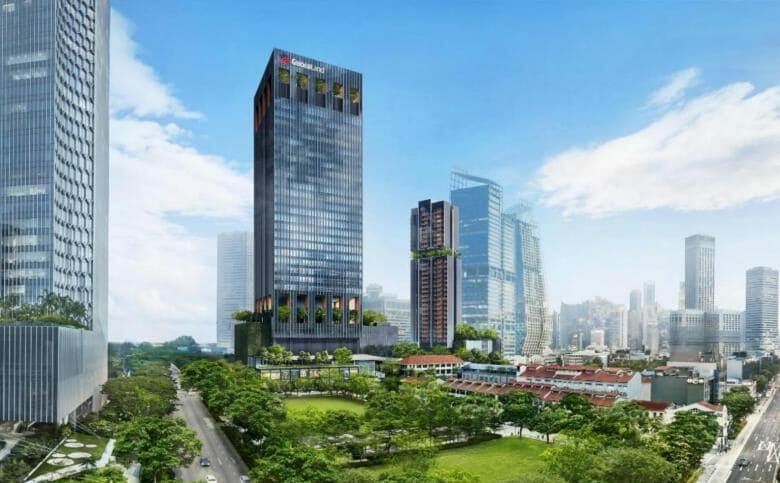
Guoco Midtown helped drive Singapore office leasing this year
Grade A office rents in Singapore’s core business districts jumped by 8.3 percent in 2022, more than double last year’s growth rate, as vacancies fell and more employees returned to their desks, according to data from CBRE Research.
CBRE said gross effective rents for grade A offices in the core CBD rose for the seventh straight quarter to S$11.70 per square foot per month by the end of 2022, after climbing by 3.8 percent last year.
A gradual return to the office which began in 2021 carried over into this year, and Singapore’s full lifting of COVID-19 restrictions since late April added impetus for occupiers to adjust their corporate real estate needs, with many choosing to expand.
“Amidst some right-sizings and consolidations across various sectors, we have seen net expansions coming from the technology, wealth management as well as the flexible workspace operators,” said David McKellar, co-head of office services for Singapore at CBRE, in a recent report.
Islandwide Vacancy Falls to 5%
Robust levels of new leases and tightening vacancy helped buoy office rents over the course of the year, with islandwide vacancy dropping from 6.3 percent at the end of 2021 to 5 percent at present.

David McKellar of CBRE
Net absorption, or the change in the amount of occupied space, for the island hit 1.15 million square feet (106,840 square metres) this year, more than triple last year’s net take-up of 320,000 square feet, and higher than the 10-year average of 970,000 square feet per year from 2013 through 2022.
The addition of GuocoLand’s Guoco Midtown mixed-use project in Singapore’s Beach Road-Ophir area helped drive new leasing in the second half of the year, according to CBRE.
Scheduled for completion by the end of this year, the development’s 30-storey, 770,000 square foot (71,535 square metre) office tower has achieved 75 percent pre-commitment of its office space to date, GuocoLand told EdgeProp in early December.
Weaker Demand in 2023
Despite the strong year, analysts have seen grade A office demand begin to cool towards the end of 2022, with signs of weakening market sentiment among larger occupiers, especially in the tech sector.
Grade A rents in the core CBD market rose by 0.9 percent at the end of 2022 compared to the previous three months — slower than the third quarter’s blistering 2.7 percent growth rate. CBRE cut its 2023 forecast for core CBD rental growth to 1 percent from its previous expectation of 4 to 5 percent.
In its outlook report for 2023, rival brokerage Cushman & Wakefield projected that grade A office rents in the CBD will grow by 2 to 4 percent year-over-year, cooling from this year’s 6.1 percent annual growth.
“At the same time, potential redevelopments in the CBD could tighten office supply and drive displacement demand, leading to higher demand in the Grade B office market, where rents are lower with more available options,” the agency added, forecasting that grade B office rents in the CBD will rise by 2.1 percent year-over-year in 2023, following 2.2 percent growth in 2022.
Softer demand will likely have “little impact” on landlords with limited exposure to vacancy or with few tenants holding unused “shadow space,” noted McKellar in CBRE’s report. He added that landlords that could be affected by immediate availability should consider offering more competitive commercial terms as they vie for tenants in the first half next year.
Softer market conditions could give occupiers an opportunity to rethink their office requirements, McKellar reasoned. “Some tenants who are inclined to reduce their footprint can take this opportunity to upgrade to smaller but better-quality offices.”
Tech Layoffs Temper Growth
Turmoil in the global tech sector has weighed on Singapore this year, and CBRE notes that layoffs and hiring freezes in the industry have prompted some companies to shrink their real estate footprints in a bid to cut costs.
Technology firms accounted for about 40 to 50 percent of total leasing demand in Singapore over the past two years, bolstering the city-state’s status as a regional tech hub.
Some tech firms have handed over the keys to their office on an early surrender basis, the agency said. Uncertainty in the sector could help boost the amount of shadow space in Singapore to 700,000 square feet (65,032 square metres) next year from 200,000 square feet (18,580 square metres) in the third quarter of 2022.
Technology firms in Singapore laid off about 1,270 workers from July to mid-November — almost five times the 260 job cuts recorded in the first half of the year — according to the country’s Manpower Minister Tan See Leng.
High-profile layoffs included Singaporean gaming and e-commerce giant Sea Limited making two rounds of major job cuts this year, in June and September, according to reports. The company had 67,300 employees as of the end of 2021.
A number of employees at Facebook parent Meta’s office at Marina One, which serves as the company’s Asia Pacific headquarters, reportedly were also laid off after the US social media giant decided to slash 13 percent of its global workforce in November.
Leave a Reply